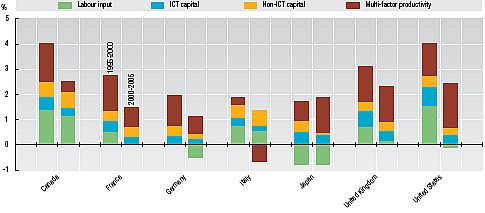I happened to be looking at the 2007 OECD Science, Technology and Industry Scorecard, and noticed a chart on “Growth Accounts for OECD Countries”. I’ve never thought of a breakdown this way, so I was intrigued by the legend.
We naturally think of labour inputs, and capital inputs, but I didn’t realize that there were statistics that break out ICT capital (in blue) from non-ICT capital (in orange). Information and Communications Technologies (ICT) isn’t something that Karl Marx specifically thought about. The OECD reports acknowledges that breaking economic growth down into factors of production is tricky thing.
Economic growth can be increased by increasing the amount and types of labour and capital used in production, and by attaining greater overall efficiency in how these factors of production are used together, i.e. higher multifactor productivity. Growth accounting involves breaking down growth of GDP into the contribution of labour input, capital input and MFP. The growth accounting model is based on the microeconomic theory of production and rests on a number of assumptions ….1
Assuming that we really can break down factors contributing to growth by labour, ICT capital, and non-ICT capital — as well as some multi-factor productivity that can’t be broken down — what does it look like? Look at the blue bar in the view of the G7 countries …
Contributions to GDP growth, G7 countries, 1995-2000 and 2000-05
(percentage points)
I happened to be looking at the 2007 OECD Science, Technology and Industry Scorecard, and noticed a chart on “Growth Accounts for OECD Countries”. I’ve never thought of a breakdown this way, so I was intrigued by the legend.
We naturally think of labour inputs, and capital inputs, but I didn’t realize that there were statistics that break out ICT capital (in blue) from non-ICT capital (in orange). Information and Communications Technologies (ICT) isn’t something that Karl Marx specifically thought about. The OECD reports acknowledges that breaking economic growth down into factors of production is tricky thing.
Economic growth can be increased by increasing the amount and types of labour and capital used in production, and by attaining greater overall efficiency in how these factors of production are used together, i.e. higher multifactor productivity. Growth accounting involves breaking down growth of GDP into the contribution of labour input, capital input and MFP. The growth accounting model is based on the microeconomic theory of production and rests on a number of assumptions ….1
Assuming that we really can break down factors contributing to growth by labour, ICT capital, and non-ICT capital — as well as some multi-factor productivity that can’t be broken down — what does it look like? Look at the blue bar in the view of the G7 countries …
Contributions to GDP growth, G7 countries, 1995-2000 and 2000-05
(percentage points)




